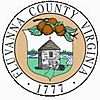Fluvanna County, Virginia facts for kids
Quick facts for kids
Fluvanna County
|
|||||
|---|---|---|---|---|---|
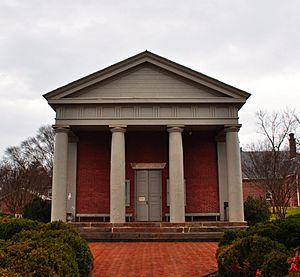
Fluvanna County Courthouse in Palmyra, January 2014
|
|||||
|
|||||
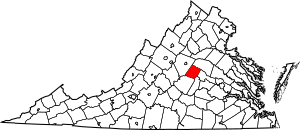
Location within the U.S. state of Virginia
|
|||||
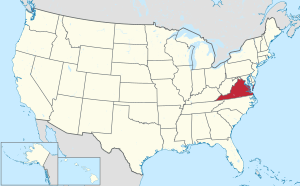 Virginia's location within the U.S. |
|||||
| Country | |||||
| State | |||||
| Founded | 1777 | ||||
| Named for | Fluvanna River | ||||
| Seat | Palmyra | ||||
| Largest community | Lake Monticello | ||||
| Area | |||||
| • Total | 290 sq mi (800 km2) | ||||
| • Land | 286 sq mi (740 km2) | ||||
| • Water | 4.1 sq mi (11 km2) 1.4% | ||||
| Population
(2020)
|
|||||
| • Total | 27,249 | ||||
| • Density | 94.0/sq mi (36.3/km2) | ||||
| Time zone | UTC−5 (Eastern) | ||||
| • Summer (DST) | UTC−4 (EDT) | ||||
| Congressional district | 5th | ||||
Fluvanna County is a county in the Piedmont area of Virginia, United States. In 2020, about 27,249 people lived there. The main town, or county seat, is Palmyra. The biggest community is Lake Monticello.
Fluvanna County is part of the larger Charlottesville city area.
Contents
History of Fluvanna County
For a long time, the area that is now Fluvanna County was home to Native American tribes. A major village called Rassawek was located near where the James and Rivanna rivers meet. Around 1701, the Seneca tribe took over this area. They later sold it to the Virginia Colony in 1721.
How the County Was Formed
The land that became Fluvanna County was first part of Henrico County. This was one of the first areas set up in the Virginia Colony. Over time, this large area was divided into smaller counties.
- In 1727, it became part of Goochland County.
- In 1744, it became part of Albemarle County.
When the main town of Albemarle County moved to Charlottesville in 1762, people in the Fluvanna area had to travel far to reach it. They asked the government to create a new county. Finally, in 1777, Fluvanna County was officially created.
Naming the County
The county was named after the Fluvanna River. This was an old name for the James River in that area. "Fluvanna" means "Anne's River." It was named to honor Anne, Queen of Great Britain, who was queen until 1714. The county is sometimes called "Old Flu."
Early Days and Wars
During the American Revolutionary War, six groups of local soldiers from Fluvanna helped defend the area. In 1781, British soldiers attacked and destroyed a weapons storage area in the county. By 1782, the population had grown to about 3,300 people.
Towns like Columbia, Bernardsburg, and Wilmington were formed soon after. Churches also started to appear, like Lyles Baptist Church in 1774. The "Brick Union" Church was built in 1825 for different Christian groups to share. The town of Fork Union grew around this church.
In 1828, Palmyra became the county seat. It grew quickly after the new courthouse was finished in 1830.
Rivers and Transportation
In the late 1700s, Thomas Jefferson helped make the Rivanna River easier to travel on. He owned land along the river. People used flat-bottomed boats called batteaux to move goods. Later, canals were built to help boats travel even better. Many parts of these old canals can still be seen today.
The James River and Kanawha Canal was a very important project. It was built next to the James River in 1840. This canal was meant to connect the Chesapeake Bay to the Ohio River and the Mississippi River. This would have created a water route all the way to the Gulf of Mexico. Even though it was never fully finished, it was used by boats to carry goods and people.
Civil War and Railroads
No major battles of the American Civil War happened in Fluvanna. However, Union soldiers burned mills and bridges. They also damaged the James River and Kanawha Canal. This was done to stop trade and travel. More than 1,200 people from Fluvanna County fought for the Confederate side during the war.
After the war, the canal was fixed. But trains were becoming more popular and efficient. So, the canal was eventually replaced by railroads. In 1880, tracks were laid on the old canal path. This new railroad, the Richmond and Allegheny Railroad, helped move goods from the mountains to Richmond.
Fork Union Military Academy
Fork Union Military Academy (FUMA) started in 1898 as Fork Union Academy. It was founded by Dr. William E. Hatcher. At first, it had both boys and girls. In 1902, it became a military school to help boys learn discipline and develop physically. By 1913, it became an all-male school and changed its name. FUMA is known for its special "One Subject Plan" of learning. Many famous football players have also graduated from its Post Graduate Football team.
People of Fluvanna County
| Historical population | |||
|---|---|---|---|
| Census | Pop. | %± | |
| 1790 | 3,921 | — | |
| 1800 | 4,623 | 17.9% | |
| 1810 | 4,775 | 3.3% | |
| 1820 | 6,704 | 40.4% | |
| 1830 | 8,221 | 22.6% | |
| 1840 | 8,812 | 7.2% | |
| 1850 | 9,487 | 7.7% | |
| 1860 | 10,353 | 9.1% | |
| 1870 | 9,875 | −4.6% | |
| 1880 | 10,802 | 9.4% | |
| 1890 | 9,508 | −12.0% | |
| 1900 | 9,050 | −4.8% | |
| 1910 | 8,323 | −8.0% | |
| 1920 | 8,547 | 2.7% | |
| 1930 | 7,466 | −12.6% | |
| 1940 | 7,088 | −5.1% | |
| 1950 | 7,121 | 0.5% | |
| 1960 | 7,227 | 1.5% | |
| 1970 | 7,621 | 5.5% | |
| 1980 | 10,244 | 34.4% | |
| 1990 | 12,429 | 21.3% | |
| 2000 | 20,047 | 61.3% | |
| 2010 | 25,691 | 28.2% | |
| 2020 | 27,249 | 6.1% | |
| 2021 (est.) | 27,723 | 7.9% | |
| U.S. Decennial Census 1790–1960 1900–1990 1990–2000 2010 2020 |
|||
Population in 2020
In 2020, the U.S. Census counted 27,249 people living in Fluvanna County. Here's a look at the different groups of people:
| Race / Ethnicity | Pop 2010 | Pop 2020 | % 2010 | % 2020 |
|---|---|---|---|---|
| White | 20,318 | 20,760 | 79.09% | 76.19% |
| Black or African American | 3,913 | 3,669 | 15.23% | 13.46% |
| Native American | 44 | 68 | 0.17% | 0.25% |
| Asian | 136 | 212 | 0.53% | 0.78% |
| Pacific Islander | 10 | 7 | 0.04% | 0.03% |
| Some Other Race | 32 | 155 | 0.12% | 0.57% |
| Mixed Race or Multi-Racial | 478 | 1,271 | 1.86% | 4.66% |
| Hispanic or Latino (any race) | 760 | 1,107 | 2.96% | 4.06% |
| Total | 25,691 | 27,249 | 100.00% | 100.00% |
Economy of Fluvanna County
Fluvanna County has about 13,206 people who are part of its workforce. About 15% of these people live and work within the county. Most residents, about 84%, work in other nearby areas.
In 2020, a company called Silk City Printing moved to Fork Union, Virginia. This was a big step for the county's economy. When it's fully working, Silk City will be one of the top employers in Fluvanna.
A fun fact: Fluvanna County's Zion Crossroads water tower was named one of the top 10 best-painted water towers in 2020!
Top Employers
Here are the top 10 employers in Fluvanna County as of 2020:
- Fluvanna School Board (schools)
- Fluvanna Correctional Center for Women (a prison)
- County of Fluvanna (local government)
- Fork Union Military Academy (a school)
- AG Dillard Inc. (a business)
- BFI Transfer Systems of Virginia (a waste management company)
- Food Lion (a grocery store)
- Domino's Pizza (a restaurant)
- Lake Monticello Owners' Association (manages the Lake Monticello community)
- Fielders Choice Enterprises Inc (a business)
Geography of Fluvanna County
Fluvanna County covers a total area of 290 square miles (750 km2). Most of this, 286 square miles (740 km2), is land. The rest, 4.1 square miles (11 km2) (1.4%), is water.
- Palmyra, the county seat, is about 54 miles (87 km) from Richmond.
- It is also about 80 miles (130 km) from Dulles International Airport.
- Lake Monticello, a private community, is about 15 miles (24 km) from Charlottesville.
Neighboring Counties
Fluvanna County shares borders with these other counties:
- Louisa County – to the north
- Goochland County – to the east
- Cumberland County – to the southeast
- Buckingham County – to the south
- Albemarle County – to the west
Main Roads
These are some of the important highways that go through Fluvanna County:
 I-64
I-64 US 15
US 15 US 250
US 250 SR 6
SR 6 SR 53
SR 53
Notable People from Fluvanna County
- Texas Jack Omohundro: A famous frontier scout, actor, and cowboy. He was born on a farm in Palmyra.
- Chris Daughtry: A singer who was on the TV show American Idol. He lived in Fluvanna as a teenager.
- Eddie George: A Heisman Trophy winner and a graduate of Fork Union Military Academy.
- Vinny Testaverde: Another Heisman Trophy winner and a graduate of Fork Union Military Academy.
- Kevin Plank: The CEO and founder of Under Armour. He also graduated from Fork Union Military Academy.
- Julia A. Wood (1840-1927): A writer and composer.
- John Jasper: An important preacher who was formerly enslaved.
Communities in Fluvanna County
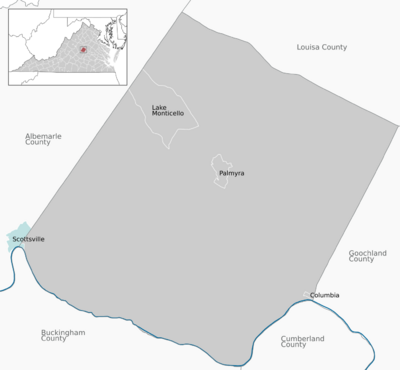
(Population numbers are from the 2020 Census)
Towns
|
Census-designated places (CDP)
|
|||
| Unincorporated Communities | ||||
See also
 In Spanish: Condado de Fluvanna para niños
In Spanish: Condado de Fluvanna para niños



